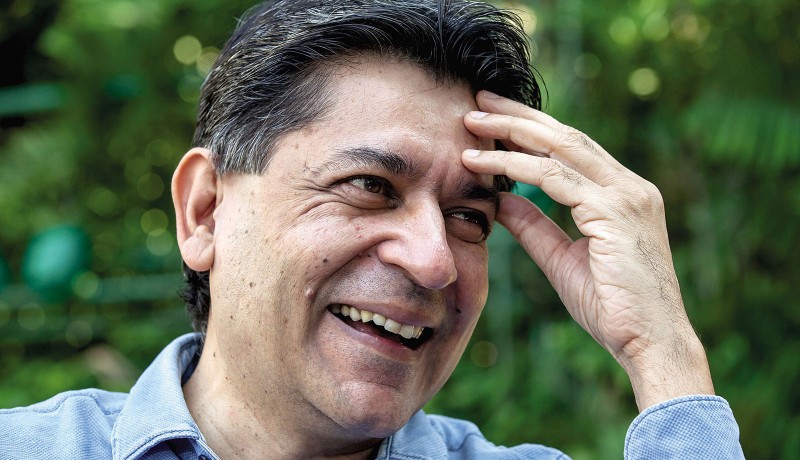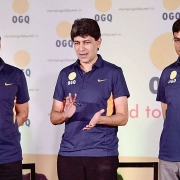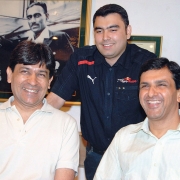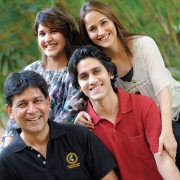
People

After conquering the world with his cue, Geet Sethi is helping India’s best and brightest sporting talent take a shot at Olympic glory, writes Neil Joshi
An incredibly successful 30-year international career in billiards and snooker is reason enough to lie back and rest on one’s laurels. But nine-time world champion cueist Geet Sethi has a greater mission: to take Indian sporting talent to the global stage. While Olympic Gold Quest (OGQ), the non-profit he cofounded with badminton legend Prakash Padukone to help Indian athletes across disciplines win Olympic gold medals, makes definitive strides, he also assists wife Kiran in the running of her Riverside School, a transformative educational experiment in student wellbeing that has gained accolades aplenty. A sporting pinup in his heyday and the third Indian to be crowned world champion after the great Wilson Jones and Michael Ferreira, his readiness to switch roles to support his wife’s career, willingness to wear new hats, from becoming an entrepreneur to an author, and thirst to read and learn, especially in the field of world economics, make the 54 year-old both intriguing and inspirational. Lounging in the comfort of the lawns of Ahmedabad’s Ellisbridge Gymkhana, Sethi tells us how self-belief lies at the heart of his success and affirms that given another shot, he would live his life “exactly the same way”.
Excerpts from the conversation.
PAST PERFECT
Your first big win was against the legendary Michael Ferreira in 1982 in the Nationals. Looking back, was it a big dream come true?
It was January 1982 at the Nationals in Chennai. Michael had won his third World Billiards Title in Malta and he came straight for the Nationals—I beat him in the final. It gave me the belief that I could beat a world champion. That was also when I realised I could devote my whole life to this game as I was also pursuing my MBA then.
Having started off early, who motivated or inspired you to take up this sport?
There was no outside inspiration or stimulus. As a 12 year-old, I used to play every sport. I was a state-level swimmer, I played badminton, table tennis, and in school I used to play basketball. I used to go to the club and peep into the billiards room. You were not allowed to enter that room till you were 18; it was a spectacle for a child with the grand table and those lovely coloured balls. Just when I turned 12, the club relaxed the rules and brought down the age to 12 years as they had got a circular from the Billiards and Snooker Federation of India [BSFI]. As the government had directed the BSFI to host a Junior Nationals tournament, the age limit was relaxed. Within two months, I stopped playing every other sport. It was so addictive—it still is.
In 1992, you broke a five-decade record while painstakingly composing a break [total scored in an inning] of 1,276 in just 80 minutes against Australian Bob Marshall at the World Professional Billiards Championship and went on to win the title. Did you feel like ruler of your domain?
I had already won two world titles in 1985 and 1987 but then encountered a bad patch. So the year 1992 signified emerging from a three-year slump. Coming out of it and playing at that level, I was more relieved rather than feeling I ruled the world! But, I felt I was playing better than 1985-87. That match gave me the justification that I could consistently beat the best in the world.
Did you ever need a change of technique?
The bad patch wasn’t easy. In 1988, I made a break of 147 points at the Snooker Nationals and that was the high point; thereafter, my game dropped. My technique crumbled as I never had played with an authentic copybook technique. I was orthodox in my game; a lot of faults crept in and I just couldn’t perform. In those three years, I had to unlearn the technique I had played with for 14 years. I had to let go of everything. I went to coaches and spoke to [Britons] Steve Davis and Frank Callan; they gave me directions and I used to come back and practise. It was extremely frustrating and I hope no sportsperson has to go through that. I was working 14-15 hours a day on my game. And when you don’t get results, you start getting despondent and going crazy.
What kind of mental state can a player experience during a drought?
If you are sliding down when you are around 45-50 years, you know your mind and body are giving way. But when you are 25 or 30 and your game starts going down, you need self-belief and conviction. Negative thoughts never came into my mind and the positivity was always there.
You have had the greatest battles with Englishman Mike Russell. Can that be considered your greatest rivalry?
My rivalry was in two stages: first it was with Michael Ferreira and then Mike Russell, both Mikes! Ferreira’s game started going down by the late 1980s but the Russell story and rivalry were phenomenal. We won 16 world titles between the two of us from 1990 to 2006; it was just us.
What were your takeaways playing Russell?
I learned that you need to consistently perform and that once you get a chance, you have to take it. On the other hand, there was a strategy aspect too. I used to play ‘the postman’s knock’ and he developed a technique called ‘the floating white’ that was sublime and finally differentiated both of us. We mastered both these strategies but I could never master the floating white the way he did.
What about the rivalry in this generation?
The current generation is dominated by Pankaj Advani; he is the man to beat. He has a rivalry with Mike Russell who still continues to play. He is ageing but still very dominant. The other is Peter Gilchrist. These two players were seven to eight years younger than me and then there’s the ‘young’ Advani. Very recently, they were in Australia playing the World Championship where Peter beat Pankaj in the ‘points format’ and Pankaj beat him in the ‘time format’.
Cue sports are not considered a common man’s game. Would you agree?
It’s an accurate statement. For a common man to play, he needs access to a billiards table, which is available only in clubs or institutes. Other than hockey, cricket and football, not every sport is a common man’s game. Where can you play badminton? Look at tennis; it is even more difficult to get access to a tennis court than a billiards table. Each municipal corporation and government should have large facilities for all sports, so children and people have access.
Do you feel the Government has done enough for the promotion of cue sports in India?
Frankly, billiards and snooker have been recognised very well, as have the players and their achievements. Ever since billiards and snooker made their entry into the Asian Games, there has been a positive change.
What is the reason for the longevity of cueists?
This sport doesn’t require physical strength. If you play for 10 days continuously, the stamina quotient does come in. But if you see [Britons] Norman Dagley and Bob Close, they played till around the age of 65. I stopped playing at the age of 53. Sport is a youth thing; after 45, I was reaching the quarters and semi-finals but wasn’t winning titles. It is quite comparable to golf. But finally your body will start failing and so will your eyesight.
What was the rationale behind your decision to retire?
As your skill and effectiveness start going down, you start getting frustrated, not because you aren’t winning but because your hand and eye coordination gets diminished and you can’t perform consistently. When you perform 20 per cent less than before, your frustration reaches a level where, one day, you say, ‘The game is giving me more frustration than joy and it’s time to call it a day.’ Also the first 20 years of your life are so blinkered that you remove every other emotion from your being. As you grow older, there is so much more that comes in to your life…your family, your children, your parents grow older. So it is a combination of all this. It was a very easy decision for me to stop playing. I had my time and achieved whatever I had to. In 2013, I lost in the quarterfinals of the World Championship; I kept my cue and never went to the club.
THE SECOND ESSAY
How did OGQ come about?
The mission was to support Indian athletes with the potential to win an Olympic medal. The Olympic medal signifies pride—for the winning athlete and the entire nation. Owing to the large size of our contingents, the Government is not in a position to support 100 per cent of each athlete’s needs. Large organisations have to look after the entire gamut and can’t focus on just the 10 people who are potential winners. So while the Government is doing 90 per cent of the work in terms of money, infrastructure and facilities, there is a 10 per cent gap. That 10 per cent can result in a performance uptake of 10-15 per cent. That’s where we come in. Because we are small and can take decisions quickly, we can be effective. If Saina Nehwal needs a 24×7 physiotherapist, a decision is taken immediately. For a government to do that, it becomes very difficult. If they are giving one to Saina, other athletes will ask for them too. So there are genuine problems for the bureaucracy and the Government. I am not blaming the Government; we just complement and finish the job. We have a very small team but that small team is available for all of my 76 athletes all day. So if Mary Kom is troubled by something, she doesn’t call her husband. She calls the OGQ office and says, ‘This is what I am going through and I need help.’
Do the athletes supported by OGQ also undergo mentorship programmes?
Prior to the London Olympics, Prakash Padukone and I gave a session to all the athletes who were leaving. Recently, Vishwanathan Anand and I spoke to our athletes. So this is an area where one can add value. We can tell them how to focus and what they need to do right. We have mental trainers with us on a consultancy basis.
Have you encountered roadblocks during the OGQ journey?
No. On the contrary, the whole journey has been positive. In fact, CSR becoming law has helped us with large companies contributing.
Would you like to see more such organisations come up in India?
I would be happy if more and more OGQs come in to the fray. We have such a vast pool of athletes and they need different kinds of support at different levels.
The London Olympics proved to be a big success for your organisation….
That was a proven concept. We started the organisation before the Beijing Olympics. We signed [shooter] Gagan Narang and [discus thrower and shot putter] Vikas Gowda six months before going to Beijing. However, the first serious Olympics were the London Games, where four of the six medal winners were supported by OGQ.
The bar has been raised for the Rio Games of 2016, not just for OGQ but the entire contingent. What is a realistic tally for us?
I think India shall double its medal tally. We got six in London and my assessment tells me we should get 12. These will come from five to six sports: shooting (two), boxing (two), wrestling (two), archery (one) and badminton (two). We are supporting 20 shooters as well as six-seven shuttlers and grapplers. Olympic medallists Sushil Kumar and Yogeshwar Dutt are with us now.
Why have you refrained from supporting team sports like hockey?
We are a small organisation. In individual sports, the benchmark and selection are objective. If you shoot 600/600, you will be selected for the team and you will win. In team sports, selection is a big problem and there are other factors. A player may play well but the team may not. You cannot just support one person. We don’t have the financial wherewithal for teams. We took this decision in the beginning. Maybe we will support
them but that’s four to five years away.
What is your opinion on sportspersons running sporting organisations?
OGQ is not only about sportspersons. It is a wonderful mix of sportspeople and individuals who run a large business. So the funding, marketing and organisational structure is looked after by Neeraj Bajaj, R Ramrajan and Shitin Desai. For pure sporting decisions, it comes down to Prakash Padukone; so both are important.
Has administration come naturally to you?
Administration doesn’t come naturally to a sportsperson. That’s why we have people who run large organisations—they look after the process and legalities, which helps create a credible and transparent organisation.
THE OTHER SIDE
Who is Geet Sethi when he is not at the billiards table?
I think I am quiet and reclusive. I have only a few friends, but very close friends. My world revolves around my family and friends. I read a lot. I want to know how world economics functions. I did my honours in economics and it is a fascinating subject.
Considering you and your wife Kiran have named your kids Raag and Jazz, do you also have a deep affinity for music?
My wife is more into music—she was a singer—and my mother was a musician so she named me Geet. I personally have no musical talent and skills. Kiran was very keen that our children’s names be associated with music. We both thought Raag was a beautiful name for our firstborn. Five years before Jazz was born, my wife read a book where the central character was named Jazz. One day she told me, ‘If we ever have a daughter, I’ll call her Jazz.’
How did you and Kiran meet?
I won my world title in August 1985 and Kiran was studying at the National Institute of Design [NID] in Ahmedabad. In September, my cousin had come over from Chandigarh; he was in a relationship with Kiran’s roommate in NID. One of Kiran’s seniors wanted to create a video for a graphic design project on Indian sport. Thus, Kiran asked her roommate to find out from my cousin if they could shoot me. The shoot took place in Ahmedabad Gymkhana, where she assisted her senior—that’s when we first met. At the end, I asked her, ‘Can I come and see you tomorrow?’ She agreed. I spoke to her every day after that. I proposed to her in eight months’ time; we will finish 30 years of marriage in 2016.
Your wife has redefined the way education is imparted with the opening of Riverside School in Ahmedabad. How did that come about?
She started the school because she became a mother. She was a totally devoted mother; when Raag was born, she had decided to work from home. Raag started at the same school I went to. When he was in kindergarten, she went to school to check on his progress. When she asked how Raag was doing, the teacher asked for his roll number. That very day, she took him out of the school, saying, ‘My son cannot be just a roll number.’ She started reading up on education. At the time, a few IIM-Ahmedabad graduates had started a school, so she enrolled Raag over there as she found they had new ideas. She then travelled around the world and visited every good school. She started doing workshops with this school and they made her a vice-principal. In two years’ time, she started her own school. By then our daughter was born. She started a school with only 20 students, starting from kindergarten. Jazz was Kiran’s first student so her involvement was very intense. The school wasn’t intended to change the world but to make an impact on her child. Now, she has reached the stage where she wants to reach out to the world. Her ‘Design for Change’ project [which endeavours to cultivate the ‘I Can’ mindset in every child] has spread to 35 countries.
How inspiring is it for you have a wife like her and how do you support her?
We draw on each other. In the first 20 years of our married life, I was totally consumed by my profession. She is at that stage now and I totally understand. There is no question of not being supportive; that is how human beings excel. I help her in her accounts and finance and seeing that the building is maintained well. It’s been a terrific journey and in January she will finish 15 years of the school.
Tell us more about yourself as a father.
I am their support system; whenever they want, I’m there. Now I am 54 and it will be my children who will always be there for me. Neither Kiran nor I have any ambitions for our children. We have grown up and realised that we need to let them be and find their own calling. Raag teaches at the school. He is a musician who plays the guitar and runs a jazz band. Jazz is a dancer. She is an instructor in a dance school called Spin.
How important was it for you to balance your education and sport and get a job?
Being well-educated is all about removing risks. Parents ask children to study to eliminate risk. My father was from a middle-class background and said, ‘Play how much ever you want but get 60 per cent in your exams!’ So two months before my board exams, I would keep my cue aside and start studying. I did my BA and MBA but I was totally focussed on my sport. On a flight back from Bangalore to Bombay, I was interviewed by Mr V K Bali from Tomco [Tata Oil Mills Company] who offered me a job on the flight. He was a sports buff.
Do you credit your education for bringing out the entrepreneur in you?
I don’t think an MBA can bring out the entrepreneur in you. That is an inborn thing where you can take risks and playing sports was very risky. An entrepreneur goes with his gut instinct and takes risks. It wasn’t the education in me that made me an entrepreneur but the sportsperson in me because I could take risks.
What about Geet Sethi, the author?
The idea behind the book Success Versus Joy wasn’t mine; it was Sunil Agarwal’s, who is the co-author and was following my career. He was a big billiards fan and he said, ‘I will come up with questions and you just answer.’ I will give all the credit to Sunil—the story and thoughts are mine but he brought out the author in me.
Do you feel you need to achieve more?
It is an ongoing process. At present, I am reading a lot and am intrigued by the economy and what is happening around the world with large corporations. I’ve had the opportunity to meet some brilliant minds; through Kiran, I have met professors from Harvard University. I have lived life passionately and with full intensity—and I continue to do so. I have no regrets.
TITLES
World Professional Billiards Champion: 1992, 1993, 1995, 1998, 2006
World Amateur Billiards Champion: 1985, 1987, 2001
Gold Medallist: 13th Asian Games, Bangkok 1998
Asian Billiards Champion: 1987
National Billiards Champion: 1982, 1985, 1986, 1987, 1988, 1997, 1998
National Snooker Champion: 1985, 1986, 1987 and 1988
MILESTONES
1985: Won the IBSF World Amateur Billiards Championships vs. Bob Marshall in an eight-hour-long final round
1986: Received the Padma Shri and Arjuna Award
1987: Won the IBSF event, as well as the ACBS Asian Billiards Championship. He won another World Amateur Billiards title in 2001, despite having previously played as a pro
1989: Achieved the world’s first amateur maximum break of 147 in an official competition in snooker at Guntur, Andhra Pradesh
1992: In the World Professional Billiards Championship, he constructed a world-record English billiards break of 1,276 in 80 minutes under the three-pot rule, also the highest break in five decades, and won first place
1992–1993: Received the Rajiv Gandhi Khel Ratna, India’s highest sporting honour
2005: Released autobiographical motivational book, Success Versus Joy
2006: Last won a World Professional Billiards Championship, overcoming England’s Lee Lagan
2013: Retired from the sport
Photo: Samir Pathak Archival images courtesy: Geet Sethi Featured in Harmony — Celebrate Age Magazine January 2016
you may also like to read
-
For the love of Sanskrit
During her 60s, if you had told Sushila A that she would be securing a doctorate in Sanskrit in the….
-
Style sensation
Meet Instagram star Moon Lin Cocking a snook at ageism, this nonagenarian Taiwanese woman is slaying street fashion like….
-
Beauty and her beast
Meet Instagram star Linda Rodin Most beauty and style influencers on Instagram hope to launch their beauty line someday…..
-
Cooking up a storm!
Meet Instagram star Shanthi Ramachandran In today’s web-fuelled world, you can now get recipes for your favourite dishes at….










